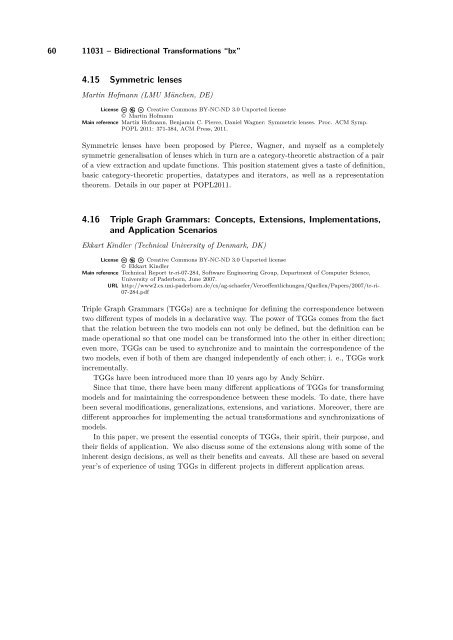Volume 1, Issue 1, January 2011 - DROPS - Schloss Dagstuhl
Volume 1, Issue 1, January 2011 - DROPS - Schloss Dagstuhl
Volume 1, Issue 1, January 2011 - DROPS - Schloss Dagstuhl
You also want an ePaper? Increase the reach of your titles
YUMPU automatically turns print PDFs into web optimized ePapers that Google loves.
60 11031 – Bidirectional Transformations “bx”<br />
4.15 Symmetric lenses<br />
Martin Hofmann (LMU München, DE)<br />
License Creative Commons BY-NC-ND 3.0 Unported license<br />
© Martin Hofmann<br />
Main reference Martin Hofmann, Benjamin C. Pierce, Daniel Wagner: Symmetric lenses. Proc. ACM Symp.<br />
POPL <strong>2011</strong>: 371-384, ACM Press, <strong>2011</strong>.<br />
Symmetric lenses have been proposed by Pierce, Wagner, and myself as a completely<br />
symmetric generalisation of lenses which in turn are a category-theoretic abstraction of a pair<br />
of a view extraction and update functions. This position statement gives a taste of definition,<br />
basic category-theoretic properties, datatypes and iterators, as well as a representation<br />
theorem. Details in our paper at POPL<strong>2011</strong>.<br />
4.16 Triple Graph Grammars: Concepts, Extensions, Implementations,<br />
and Application Scenarios<br />
Ekkart Kindler (Technical University of Denmark, DK)<br />
License Creative Commons BY-NC-ND 3.0 Unported license<br />
© Ekkart Kindler<br />
Main reference Technical Report tr-ri-07-284, Software Engineering Group, Department of Computer Science,<br />
University of Paderborn, June 2007.<br />
URL http://www2.cs.uni-paderborn.de/cs/ag-schaefer/Veroeffentlichungen/Quellen/Papers/2007/tr-ri-<br />
07-284.pdf<br />
Triple Graph Grammars (TGGs) are a technique for defining the correspondence between<br />
two different types of models in a declarative way. The power of TGGs comes from the fact<br />
that the relation between the two models can not only be defined, but the definition can be<br />
made operational so that one model can be transformed into the other in either direction;<br />
even more, TGGs can be used to synchronize and to maintain the correspondence of the<br />
two models, even if both of them are changed independently of each other; i. e., TGGs work<br />
incrementally.<br />
TGGs have been introduced more than 10 years ago by Andy Schürr.<br />
Since that time, there have been many different applications of TGGs for transforming<br />
models and for maintaining the correspondence between these models. To date, there have<br />
been several modifications, generalizations, extensions, and variations. Moreover, there are<br />
different approaches for implementing the actual transformations and synchronizations of<br />
models.<br />
In this paper, we present the essential concepts of TGGs, their spirit, their purpose, and<br />
their fields of application. We also discuss some of the extensions along with some of the<br />
inherent design decisions, as well as their benefits and caveats. All these are based on several<br />
year’s of experience of using TGGs in different projects in different application areas.













